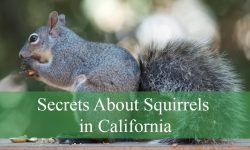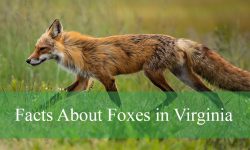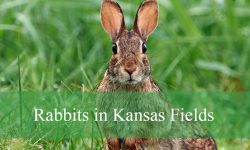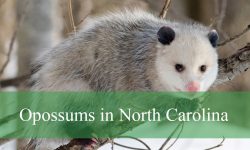Kansas is home to a wide variety of reptiles, and lizards are some of the most active and fascinating among them. These reptiles can be found in prairies, forests, rocky hillsides, and even suburban parks. Lizards in Kansas play an important role in nature by helping to control insect populations and supporting the balance of local ecosystems.
Some lizards are small and secretive, while others are quick and colorful. Common species like the Six-lined Racerunner and Prairie Skink are often seen darting across sunny paths or basking on warm rocks. Each lizard in Kansas has its own appearance, behavior, and preferred habitat, making them fun to learn about and identify.
This article introduces 8 common lizards in Kansas, complete with pictures and simple identification tips. It also includes information on where to find them and when they are most active. Exploring this list is a great way to learn more about the native lizard species that live throughout the state.
Different Types of Lizards in Kansas
Prairie Skink (Plestiodon septentrionalis)

The Prairie Skink is a small and slender lizard commonly found across Kansas, especially in grasslands and prairie ecosystems. It typically measures between 4 and 7 inches in total length, including the tail. Its smooth, shiny scales give it a sleek appearance, and its coloration usually ranges from reddish-brown to a lighter tan, often with subtle darker stripes running along its back. The Prairie Skink’s tail can sometimes appear blue, particularly in juveniles, which helps with camouflage and predator distraction.
Identifying the Prairie Skink is relatively straightforward due to its slender body shape, smooth scales, and reddish hue. Unlike some other skinks with more pronounced patterns, this species has a more uniform coloration with less distinct markings. Its small head and pointed snout help it move easily through grass and loose soil as it searches for prey.
In terms of behavior, Prairie Skinks are active during the day and are excellent burrowers. They often take refuge under rocks, logs, or within loose soil to escape predators and extreme temperatures. Their diet mainly consists of insects and small invertebrates, which they hunt actively using quick movements. When threatened, they may shed their tail to distract predators and escape.
Prairie Skinks are widely distributed throughout Kansas, favoring dry, open habitats such as prairies, grasslands, and fields. They thrive in environments with loose, sandy or loamy soils where they can easily burrow and find cover. This skink is a common reptile across the state and plays a role in controlling insect populations in its ecosystem.
Six-lined Racerunner (Aspidoscelis sexlineata)
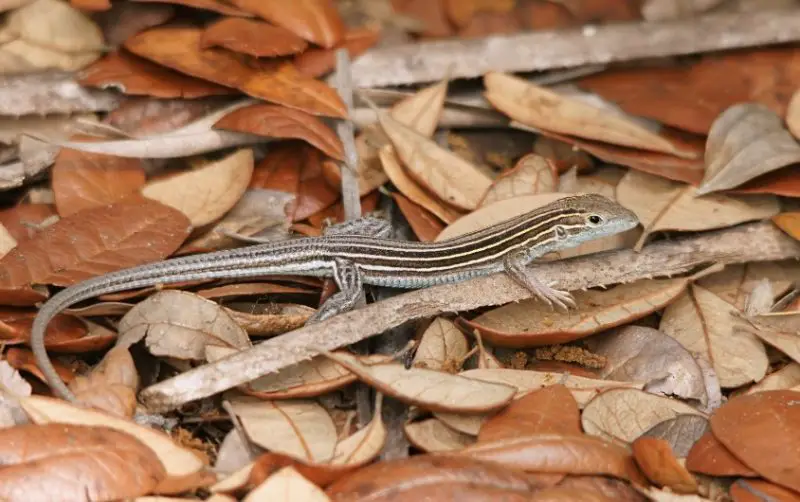
The Six-lined Racerunner is a fast-moving, slender lizard known for its distinctive six bright yellow stripes running down a dark brown or blackish body. Adult racerunners typically range from 5 to 7.5 inches in length. Their long tail can make up more than half their total length, aiding in balance during high-speed chases. This species’ smooth scales shimmer in the sunlight, and their sharp vision helps them detect both prey and predators in open terrain.
The key identifying feature of the Six-lined Racerunner is its six clear yellow stripes extending from the head to the tail, set against a darker background. These stripes are usually straight and parallel, making this lizard one of the easiest to recognize in Kansas. Their slender legs and toes allow for rapid acceleration and agile turns as they dart across sandy or open soil.
Behaviorally, racerunners are diurnal and are some of the fastest lizards in North America, often seen sprinting across open areas to catch insects. They are highly active hunters that rely on their speed to both capture prey and escape threats. During cooler parts of the day, they may bask on rocks or bare ground to regulate their body temperature.
In Kansas, the Six-lined Racerunner favors open, sandy habitats such as riverbanks, dunes, and sandy prairies. They are more common in the eastern and central parts of the state where suitable terrain exists. Their preference for loose, dry soil helps them maintain high mobility and provides access to abundant insect prey.
Eastern Fence Lizard (Sceloporus undulatus)
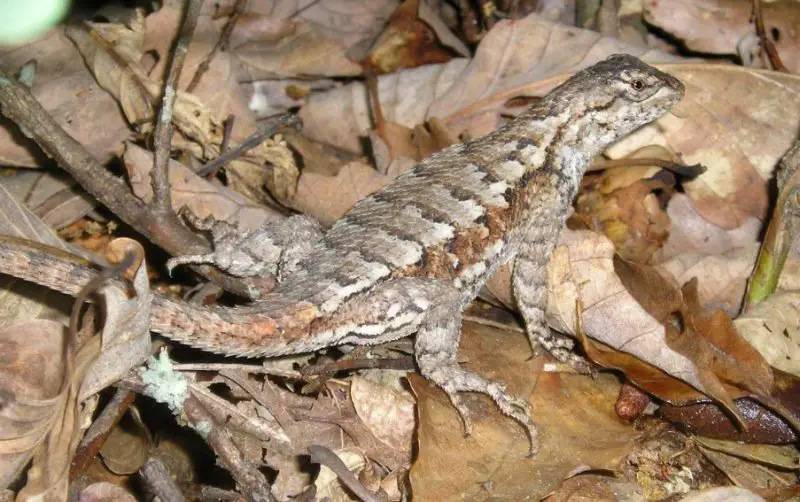
The Eastern Fence Lizard is a medium-sized reptile, measuring about 5 to 7 inches in length, including the tail. It has rough, spiny scales that give it a textured appearance, with coloration typically ranging from grayish to brown, often mottled with darker patterns for camouflage. Males often display blue patches on their throats and bellies during breeding season, making them easier to identify among other lizards.
This species is commonly found perched on fences, tree trunks, rocks, and logs, where it basks in the sun and surveys its territory. The rough scales and flattened body aid in gripping vertical surfaces and navigating rugged environments. Their sharp claws allow for climbing, and their keen eyesight helps spot prey and predators from a distance.
Eastern Fence Lizards are diurnal and territorial, often displaying head-bobbing and push-up behaviors to communicate with rivals and potential mates. Their diet mainly consists of insects such as ants, beetles, and spiders. When threatened, they may quickly dash into crevices or thick vegetation to hide.
In Kansas, Eastern Fence Lizards are most commonly found in wooded areas, forest edges, and urban parks, especially in the eastern regions of the state. Their adaptability to a variety of habitats, including suburban environments, makes them a frequently observed lizard in both natural and developed areas.
Great Plains Skink (Plestiodon obsoletus)
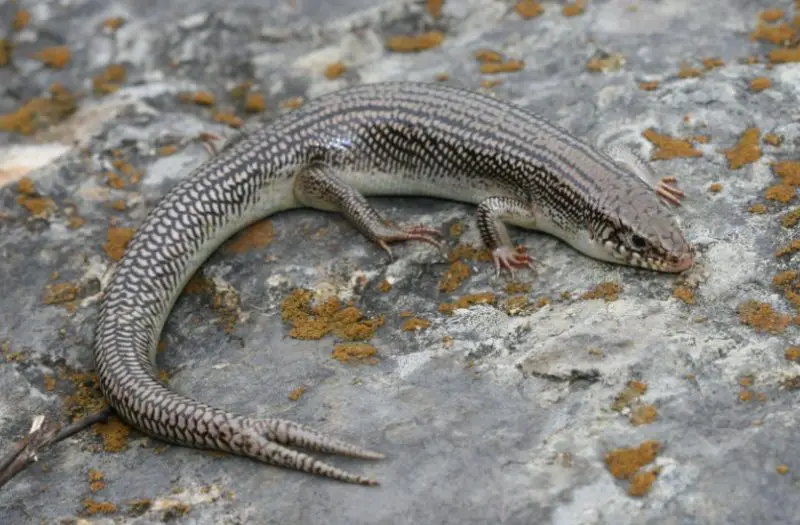
The Great Plains Skink is among the largest skink species in Kansas, reaching lengths of 8 to 14 inches, with a robust body and a long tail. Its smooth, shiny scales usually have a brown or gray coloration, often with subtle darker spots or stripes. Juveniles may have bright blue tails that fade as they mature. This skink’s broad head and strong jaws reflect its active predatory lifestyle.
Visually, the Great Plains Skink is distinguished by its size and glossy scales. It has powerful legs with sharp claws used for digging and climbing over rocky terrain. Its relatively large head and stout body give it a sturdy appearance compared to more slender lizards in the area.
Great Plains Skinks are primarily diurnal and ground-dwelling but can also be found climbing on low vegetation or rocks. They are excellent burrowers, often creating or using existing holes for shelter. Their diet consists of a variety of insects, spiders, and occasionally small amphibians or reptiles. When threatened, they can shed their tail to evade predators, a defense mechanism common among skinks.
In Kansas, this species prefers rocky hillsides, bluffs, and mixed-grass prairies, especially in the western and central parts of the state. Its presence is most common where there are plenty of rocks and crevices that offer shelter from predators and extreme weather conditions. The Great Plains Skink plays a vital role in the ecosystem by controlling insect populations and serving as prey for larger predators.
Prairie Racerunner (Aspidoscelis sexlineata viridis)
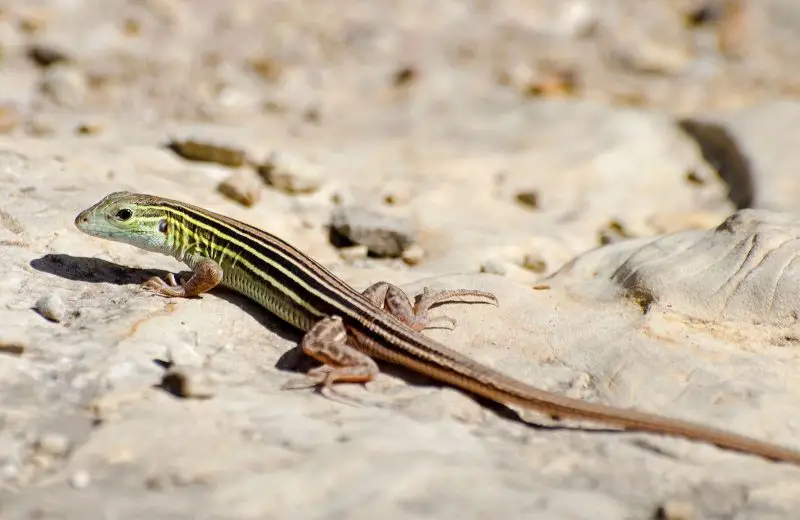
The Prairie Racerunner is a subspecies of the Six-lined Racerunner, notable for its bright greenish-yellow coloration that distinguishes it from other racerunners. Adults typically measure 5 to 7 inches long, with a slender body and an even longer tail that aids in balance and agility. Its body is adorned with six bold yellow stripes running from head to tail, contrasting vividly against its darker background color. The Prairie Racerunner’s scales are smooth and shiny, reflecting sunlight as it dashes across open terrain.
Identification of the Prairie Racerunner is fairly straightforward due to its bright coloration and distinctive striping. Unlike some other lizards with more muted colors, this racerunner’s vibrant greenish hue and clear stripes make it stand out, especially in its preferred sandy habitats. Its long limbs and toes enable rapid acceleration and quick turns, characteristics essential for escaping predators and chasing prey.
Behaviorally, the Prairie Racerunner is diurnal and highly active. It spends much of its time sprinting across open prairies, sandy riverbanks, and grasslands, hunting insects, spiders, and other small invertebrates. Its speed and agility make it one of the fastest lizards in Kansas, and it often uses its swiftness to evade threats. It is wary and skittish, typically fleeing at the first sign of danger.
In Kansas, the Prairie Racerunner is primarily found in central and southern regions where sandy soils and open prairies dominate the landscape. It favors dry, loose soils that allow for fast running and burrowing. These habitats provide both the cover and the insect prey necessary for its survival. Conservation of prairie ecosystems is crucial for maintaining healthy populations of this vibrant lizard.
Slender Glass Lizard (Ophisaurus attenuatus)
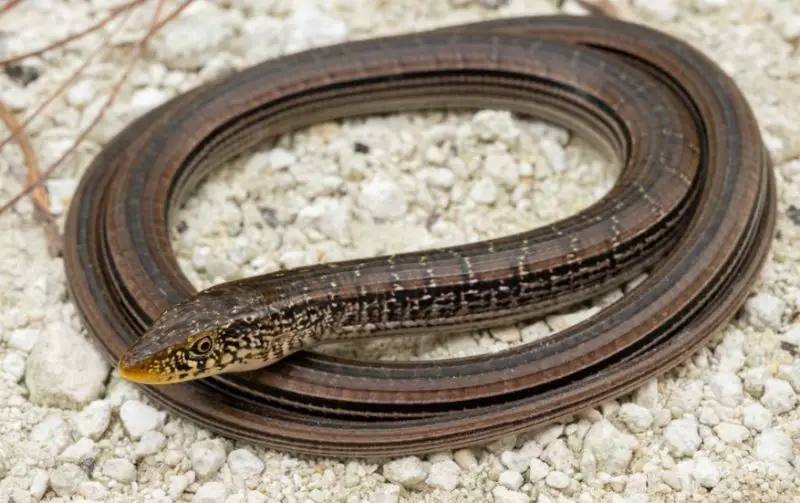
The Slender Glass Lizard is a legless lizard that closely resembles a snake but can be distinguished by its eyelids and external ear openings. Adults range from 18 to 24 inches in length, with a slender, elongated body covered in smooth, shiny scales. Its coloration varies from light brown to gray, often with faint striping or mottling that helps it blend into leaf litter and grass. The tail is fragile and can break off in several pieces when the lizard is threatened, giving rise to the name “glass lizard.”
Identification hinges on noting its snake-like appearance alongside the presence of eyelids and ears, which snakes lack. Unlike snakes, the Slender Glass Lizard cannot constrict prey but hunts mainly by quick strikes. Its tongue is forked and used for sensing the environment, similar to snakes. Its smooth, shiny scales give it a sleek appearance, and it often moves with a sinuous, undulating motion.
The Slender Glass Lizard is primarily nocturnal and secretive, spending much of its time hidden under logs, rocks, and dense vegetation. It inhabits grassy fields, open woodlands, and prairie edges where it can find shelter and prey. Its diet consists of insects, spiders, small rodents, and occasionally eggs. When disturbed, it employs tail autotomy as a defense mechanism to escape predators.
In Kansas, this species is scattered but can be found throughout the eastern and central parts of the state where suitable habitat exists. It prefers areas with abundant ground cover and loose soil for burrowing. Because it is rarely seen due to its secretive nature, the Slender Glass Lizard is often overlooked despite its relative abundance.
Broad-headed Skink (Plestiodon laticeps)
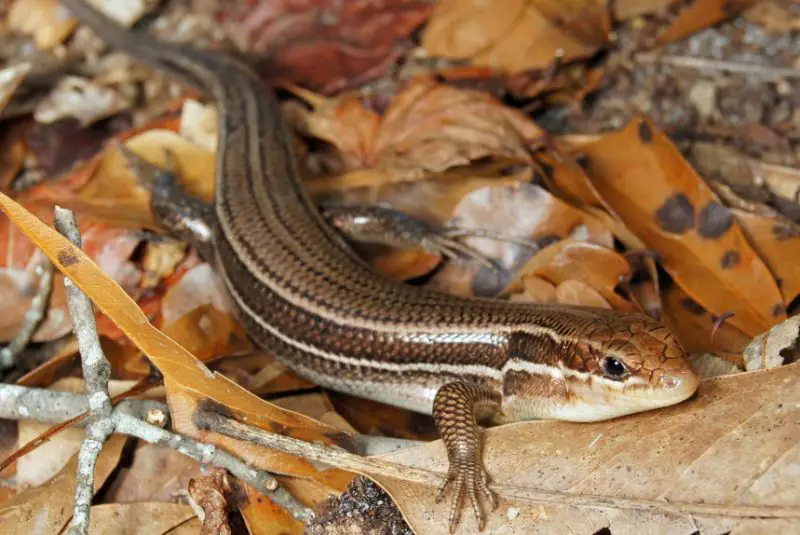
The Broad-headed Skink is one of the largest skinks found in the United States, with adults reaching up to 12 inches in length. It is named for its distinctly broad, triangular head, which becomes brightly colored — often red or orange — in breeding males. The body is covered in smooth, shiny scales that range from brown to olive, sometimes with subtle stripes or spots. This skink has a robust build and strong limbs, making it an excellent climber.
Identification of the Broad-headed Skink is aided by its size, head shape, and seasonal coloration changes in males. During the breeding season, the males’ heads become vividly colored, signaling territorial and mating behavior. Outside of this time, they exhibit more muted tones that help them blend into wooded environments. Their long, powerful tails help maintain balance while climbing.
Broad-headed Skinks are primarily arboreal and diurnal. They are often found climbing trees, logs, and shrubs in forested areas, where they hunt for insects, spiders, and small amphibians. Their behavior includes basking in sunlit spots and quick darting movements through foliage. Males can be territorial, often engaging in displays to ward off rivals.
In Kansas, Broad-headed Skinks are rare but present mostly in the eastern regions where mature forests are found. Their presence is limited due to habitat availability, but they contribute to the ecological balance by controlling insect populations. Conservation of forest habitats is key to preserving this impressive skink species.
Best Places and Times to Spot Lizards in Kansas
Kansas offers many excellent locations for observing its diverse lizard species, thanks to its mix of prairies, woodlands, and river valleys. Some of the best places to see lizards include:
-
Tallgrass Prairies and Grasslands: Areas like the Flint Hills region provide ideal habitat for species such as the Prairie Skink and Six-lined Racerunner. These open spaces with sandy or loamy soils allow lizards to bask and hunt freely.
-
River Valleys and Sandy Banks: The Kansas River corridor and Arkansas River valleys are good spots to find racerunners and skinks, especially where there are sandy patches and rocky outcrops.
-
Wooded Areas and Forest Edges: Eastern Fence Lizards and Broad-headed Skinks are more often found near forest edges, parks, and nature reserves with plenty of fallen logs, rocks, and trees.
-
Suburban Parks and Open Green Spaces: Some lizards, especially Red-backed and Eastern Fence Lizards, can adapt to suburban environments, making city parks and green belts a convenient place to observe them.
The best time to observe lizards in Kansas is during the warmer months from late spring through early fall, typically April to September. Lizards are ectothermic, meaning they rely on external heat sources to regulate their body temperature. Therefore, they are most active on sunny days when temperatures range from about 75°F to 95°F (24°C to 35°C).
Early mornings and late afternoons are prime times for lizard activity, as they bask in the sun to warm up or hunt when temperatures are optimal but not too hot. Midday can be quieter since lizards often retreat to shade or burrows to avoid overheating.
Visiting these habitats during these times increases the chances of spotting these fascinating reptiles in their natural environment. Always approach quietly and maintain a respectful distance to avoid disturbing them.

